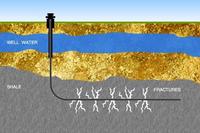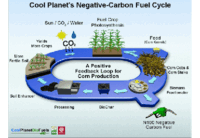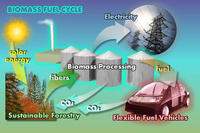-
CIA-commissioned climate change report outlines perils for U.S. national security
U.S. national security leaders believe that the accelerating pace of climate change will place severe strains on U.S. military and intelligence agencies in coming years; the reason, according the National Research Council, the U.S. top scientific research body: climate changes will trigger increasingly disruptive developments around the world; a 206-page National Research Council study, commissioned by the CIA and other U.S. intelligence services, concludes that states will fail, large populations subjected to famine, flood, or disease will migrate across international borders, and national and international agencies will not have the capacity or resources to cope with the resulting conflicts and crises
-
-
Scientists resurrect process to convert sugar directly to diesel

A long-abandoned fermentation process once used to turn starch into explosives can be used to produce renewable diesel fuel to replace the fossil fuels now used in transportation; the retooled process produces a mix of products that contain more energy per gallon than ethanol that is used today in transportation fuels and could be commercialized within 5-10 years
-
-
Hurricane Sandy offered support for reliance on nuclear power
A Scientific American writer is impressed with the way nuclear power facilities were able safely to withstand the wrath of Hurricane Sandy; the lesson he draws from this experience: “Global warming is increasing the probability and destructiveness of extreme weather events like Sandy. (I don’t see the point of dithering over this claim any more.) The last thing we should do in the face of this threat is abandon nuclear energy. If anything, we need more nuclear power, not less, to curb global warming”
-
-
Fracking: fact vs. fiction

In communities across the United States, people are hearing more and more about a controversial oil and gas extraction technique called hydraulic fracturing — aka, hydro-fracking; controversies pivot on some basic questions: Can hydro-fracking contaminate domestic wells? Does it cause earthquakes? How can we know? What can be done about these things if they are true? Experts making presentations at the Geological Society of America (GSA) meeting this week in Charlotte, North Carolina, will address these and related critical questions
-
-
Biofuels from algae hold potential, but more work required to realize that potential
Scaling up the production of biofuels made from algae to meet at least 5 percent — about ten billion gallons — of U.S. transportation fuel needs would place unsustainable demands on energy, water, and nutrients, says a new report from the National Research Council (NRC); these concerns, however, are not a definitive barrier for future production, and innovations that would require research and development could help realize algal biofuels’ full potential
-
-
Quick-cook method turns algae into oil
It looks like Mother Nature was wasting her time with a multimillion-year process to produce crude oil; University of Michigan engineering researchers can “pressure-cook” algae for as little as a minute and transform an unprecedented 65 percent of the green slime into biocrude
-
-
Calculating the benefits of switching from food to energy crops
Along with the growing interest in biomass energy crops as renewable alternatives to fossil fuels comes a growing list of questions from corn and soybean farmers about what it will cost them to switch; researchers developed a customizable online calculator to eliminate some of the guesswork and help farmers make the decision
-
-
Researchers invent safe wireless vehicle charging technology
Researchers have invented a safe, efficient technology wirelessly to charge electric vehicles using “remote magnetic gears” — a rotating base magnet driven by electricity from the grid, and a second located within the car — and successfully tested it on campus service vehicles
-
-
A coal economy has multiple health, social risks, says major review
A major review of evidence on the impact of coal mining has highlighted serious, ongoing health and social problems, and an urgent need for improvements in government coal mining policy
-
-
Human activity can trigger an earthquake
Earthquakes occur when tectonic plates try to move past each other, and the friction between them holds them in place; the friction creates energy which builds up, and when the plates move past each other, the energy is released, triggering an earthquake; fracturing increases the fluid pressure inside faults; this increased pressure, in turn, lowers the stress threshold for triggering an earthquake enough for one to take place
-
-
U.S. shale gas drives up coal exports – and CO2 emissions
U.S. CO2 emissions from domestic energy have declined by 8.6 percent since a peak in 2005, the equivalent of 1.4 percent per year; researchers warn, however, that more than half of the recent emissions reductions in the power sector may be displaced overseas by the trade in coal
-
-
Carbon-negative fuel at projected cost of less than $1.50 per gallon

Cool Planet Energy Systems the other day announced a major breakthrough in the commercialization and affordability of biofuels from non-food biomass that can run in any vehicle on the road today; a successful field testing was conducted at Google Campus
-
-
Large-scale production of algae-based biofuels poses sustainability concerns

Scaling up the production of biofuels made from algae to meet at least 5 percent — approximately thirty-nine billion liters — of U.S. transportation fuel needs would place unsustainable demands on energy, water, and nutrients, says a new report from the National Research Council; these concerns, however, are not a definitive barrier for future production, and innovations that would require research and development could help realize algal biofuels’ full potential
-
-
New biorenewables technology about to reach the marketplace

Innovative technology provides a new way to transform cellulosic biomass into renewable fuels and high-value chemicals; ,the technology uses ionic liquids to break down cellulosic or non-food plant biomass without using enzymes or costly pretreatment steps
-
-
Ideas from nature on how to convert solar into liquid fuel
It has long been a dream of scientists to use solar energy to produce chemicals which could be stored and later used to create electricity or fuels; a recent scientific breakthrough is providing hope that this may soon be possible; the development would offer many benefits, including the ability to store chemicals until needed — current solar power technology has difficulties in this area
-
More headlines
The long view
Trump Is Fast-Tracking New Coal Mines — Even When They Don’t Make Economic Sense
In Appalachian Tennessee, mines shut down and couldn’t pay their debts. Now a new one is opening under the guise of an “energy emergency.”
Smaller Nuclear Reactors Spark Renewed Interest in a Once-Shunned Energy Source
In the past two years, half the states have taken action to promote nuclear power, from creating nuclear task forces to integrating nuclear into long-term energy plans.
